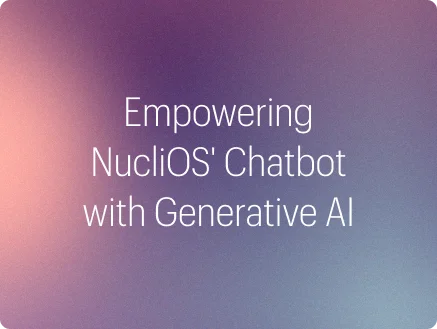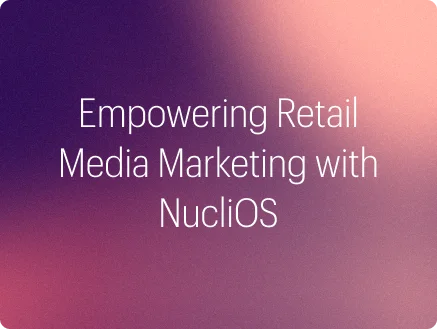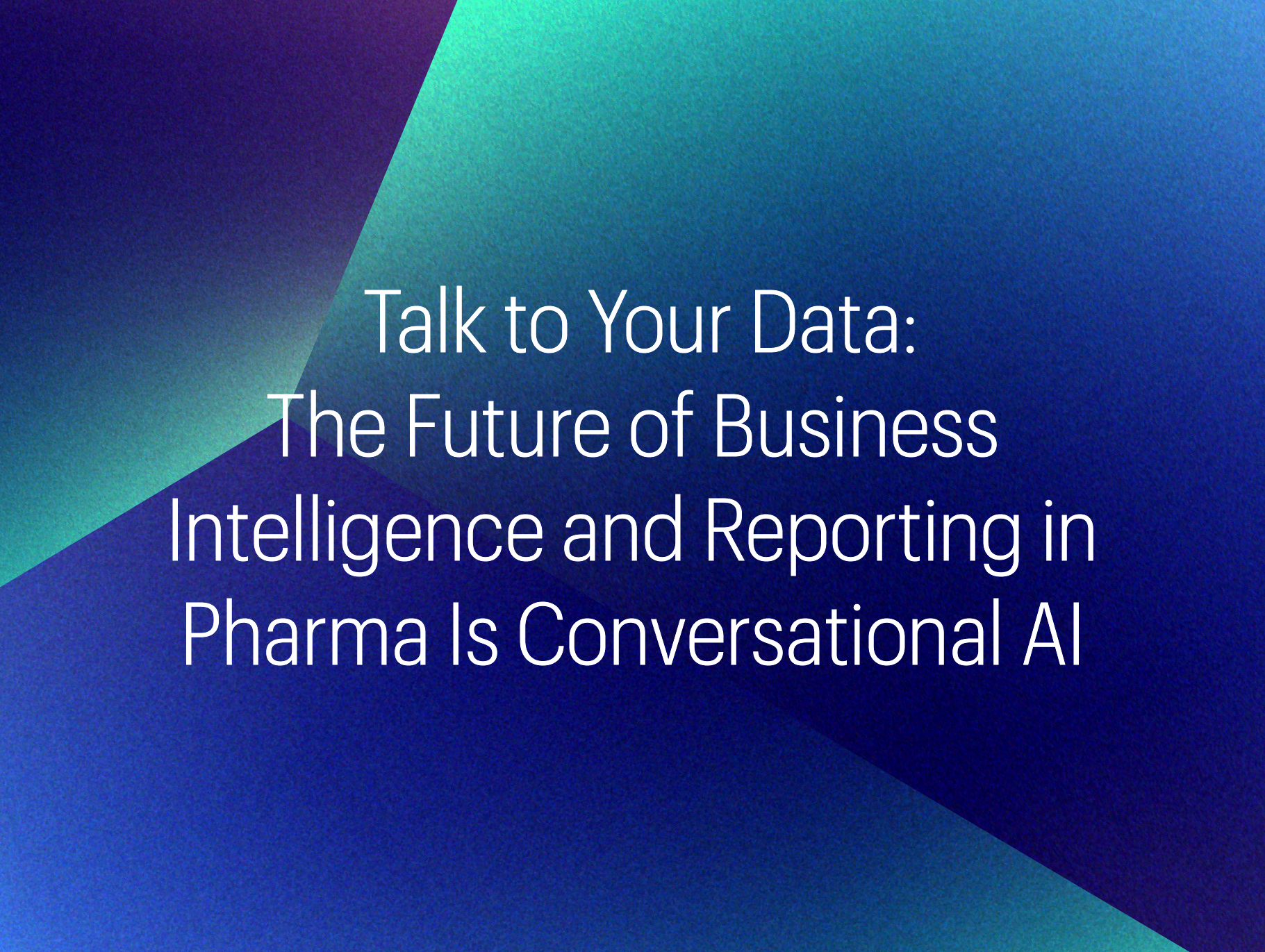Enterprises have long relied on dashboards and static chatbots to deliver insights. While functional, these tools fall short in today’s fast-moving, complex business environment. Today, organizations need systems that are not only responsive, but also contextual, predictive, and adaptive. This evolution is about more than efficiency; it’s about enabling a new mode of enterprise cognition.
The NucliOS AI Insights Assistant makes this possible. Designed as a collaborative, multi-agent system, it transforms how enterprises explore and act on data. Unlike conventional tools that stop at reporting or retrieval, NucliOS orchestrates specialized agents to investigate, reason, and recommend. It doesn’t just provide answers—it guides the entire analytical journey, uncovering what happened, why it happened, what could happen next, and the best actions to take.
With causal exploration, hypothesis-driven reasoning, and transparent auditability, NucliOS mirrors how expert analysts think—only faster, infinitely scalable, and continuously evolving with the business it supports.
How It Works: Multi-Agent Intelligence under the hood
At the heart of the AI Insights Assistant is a multi-agent system that converts a simple query into a structured, end-to-end analytical journey.
Queries can take many forms: Descriptive (What), Diagnostic (Why), Simulation/Forecasting (What if), or Proactive (AI-driven drill-down suggestions for the next best question). The system intelligently orchestrates the right agents, applies logic, and produces results that are reproducible, explainable, and transparent.
Core Agents
- Planner Agent – Designs the logical workflow, sequencing agents in the right order based on context.
- Hypothesis Agent – Identifies possible causes or contributing factors, leveraging business logic and historical data patterns.
- EDA Agent – A text-to-SQL agent that first drafts a plan, then generates and runs queries, retrieves relevant datasets, and outputs a structured data frame. It can also perform Python-based transformations when needed, while visualization is handled separately.
- Stats Agent – Tests and validates hypotheses using statistical methods such as Chi-Square, ANOVA, and Spearman/Pearson correlation, ensuring conclusions are backed by solid evidence.
- Drill-Down Agent – Builds on EDA and Stats outputs to propose context-aware follow-up questions, enabling iterative exploration of incidents, segments, or dimensions without restarting the workflow.
- Visualization Agent – Translates structured data frames into dynamic, interactive charts (e.g., Plotly) that highlight patterns and trends while retaining full data context.
- Simulation Agent – Connects LLMs with ML models for what-if analysis and scenario forecasting. By integrating models created by data science teams, it makes advanced machine learning accessible via natural language, enabling business users to run simulations (e.g., sales forecasts, pricing impacts) directly within the chat interface.
- Insights Agent – Brings everything together by synthesizing hypotheses, statistics, drill-downs, and visualizations into clear narratives, while suggesting next-best actions for decision-making.
Key Features & Core Capabilities
- Multi-Agent Intelligence- Planner, Hypothesis, EDA, Stats, Drill-Down, Visualization, and Insights Agents collaborate to emulate analyst reasoning. Together, they convert natural language queries into structured, validated, and reproducible analysis.
- Adaptive Exploration- Supports descriptive (what), diagnostic (why), and proactive (what’s next) questions. Guided by the Planner, the Assistant dynamically builds pipelines, drives drill-downs, and enables iterative, context-aware exploration.
- Causality & Conditional Reasoning- The Hypothesis Agent identifies potential explanations for “why” questions, which the Stats Agent then validates. The Planner applies conditional logic to orchestrate the right workflows, ensuring efficient and contextual resolution.
- Explainability & Transparency- Every output is traceable—backed by SQL queries, Python transformations, statistical validations, and visualizations—delivering a clear, auditable trail that is reusable and verifiable.
- Proactive Guidance- The Drill-Down Agent proposes next-step questions, while the Insights Agent synthesizes results into narratives and recommends next-best actions, ensuring investigations remain continuous and actionable.
- Enterprise Scale- Seamlessly integrates into enterprise ecosystems, scaling securely across functions. Proven performance includes processing datasets of 8.7M+ rows with ~1 minute latency—demonstrating readiness for large-scale enterprise use.
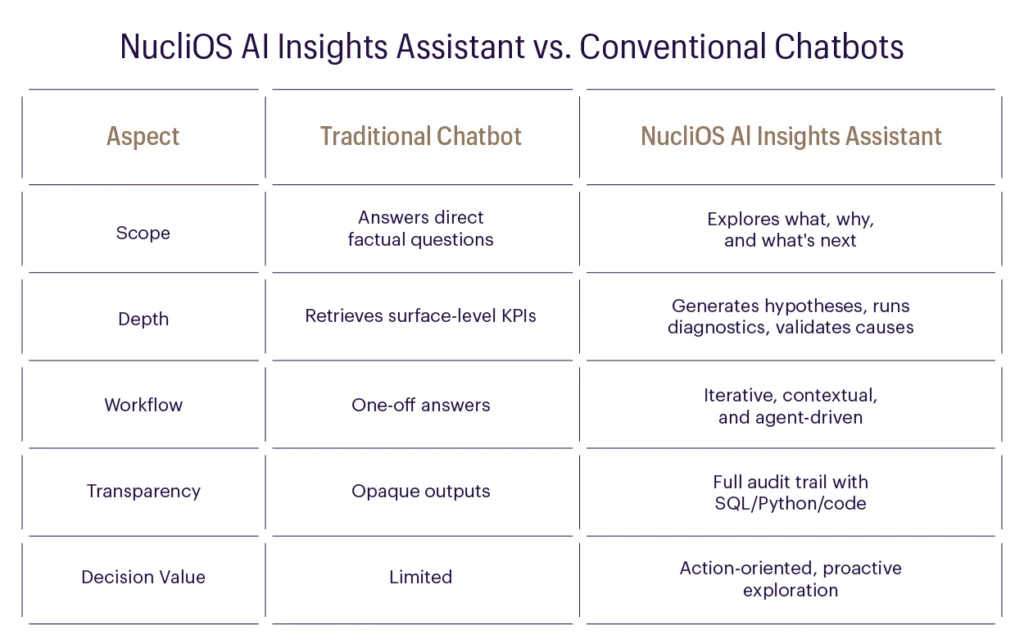
What It Delivers
The NucliOS AI Insights Assistant is an advanced multi-agent system designed to mirror the reasoning process of human analysts through specialized agents such as Planner, Hypothesis, EDA, Stats, Drill-Down, Visualization, and Insights. Rather than replacing analysts, data scientists, or business users, it enhances their work by adopting a human-in-the-loop model. Routine tasks like writing SQL, running statistical tests, and generating visualizations are automated, freeing up people to focus on interpretation, domain knowledge, and strategic decision-making. Instead of reducing the need for expertise, it amplifies – allowing analysts to move faster, data scientists to validate and iterate more effectively, and business leaders to gain sharper, more actionable insights with confidence.
Step-by-Step Scenario: Turning a Question into Insight
Example: The “What” Question (Descriptive Analysis)
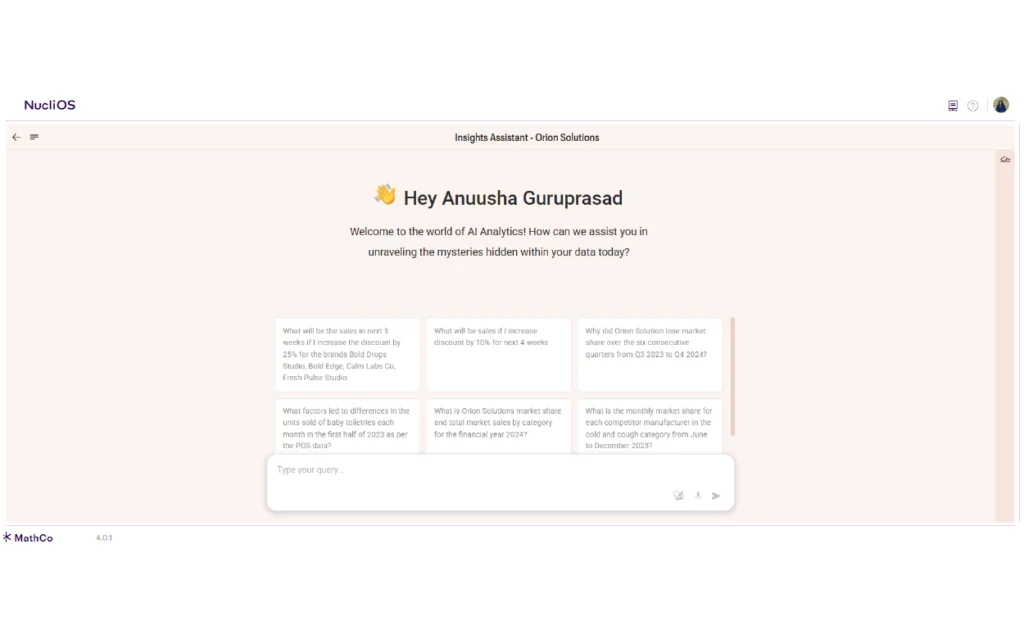
- This is the landing screen of the Insights Assistant.
- It greets the user and presents sample descriptive queries like “What is the attrition rate in the company?” or “What is Orion Solutions’ market share by category?”.
- This illustrates how the system encourages natural language input to kickstart descriptive fact-finding.
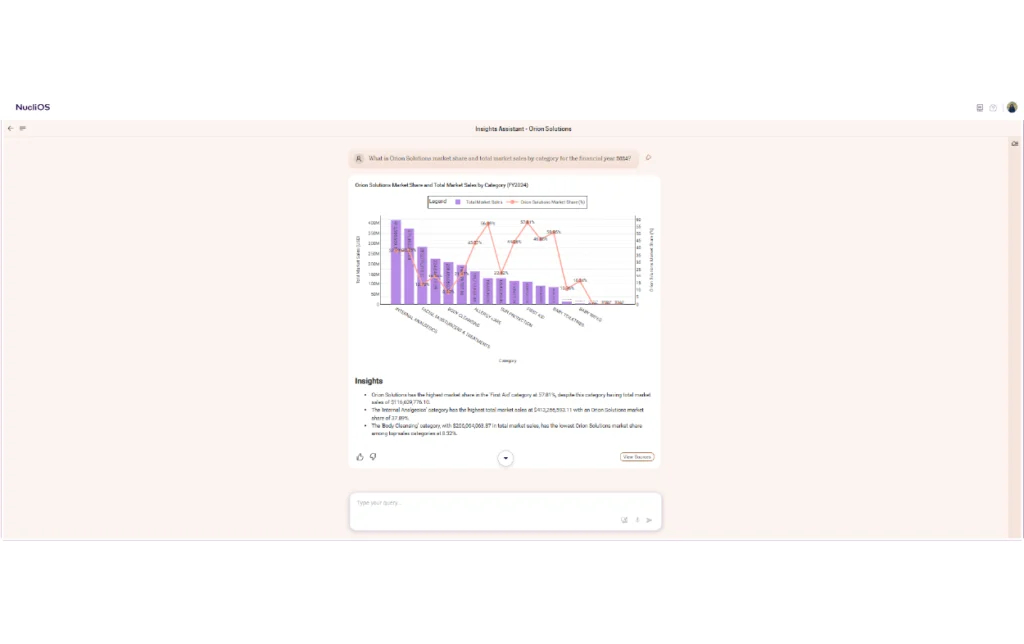
- Here the user types: “What is Orion Solutions’ market share and total market sales by category for FY2024?”.
- The Planner Agent interprets this as a descriptive query, passes it to the EDA Agent, which generates SQL, fetches the data, and then hands it to the Visualization Agent.
- The result is shown as a bar chart with insights, highlighting both Orion’s share and overall category sales.
The Why Question (Diagnostic Analysis)
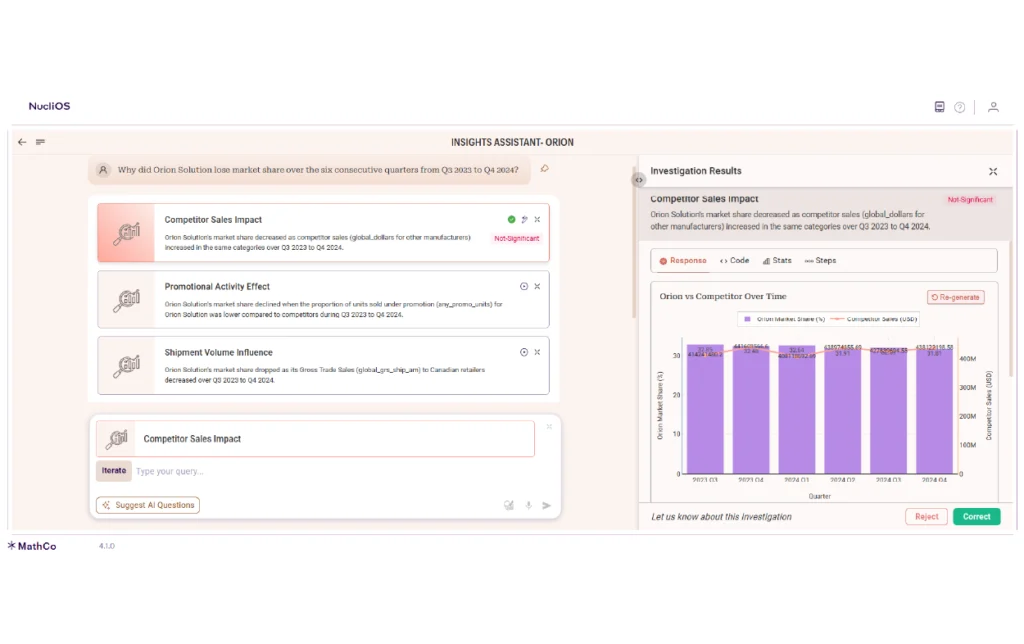
- The user asks: “Why did Orion Solution lose market share over six consecutive quarters from Q3 2023 to Q4 2024?”.
- The Hypothesis Agent generates multiple candidate explanations (competitor sales, promotions, etc.).
- Each hypothesis is presented in a list, awaiting statistical validation.
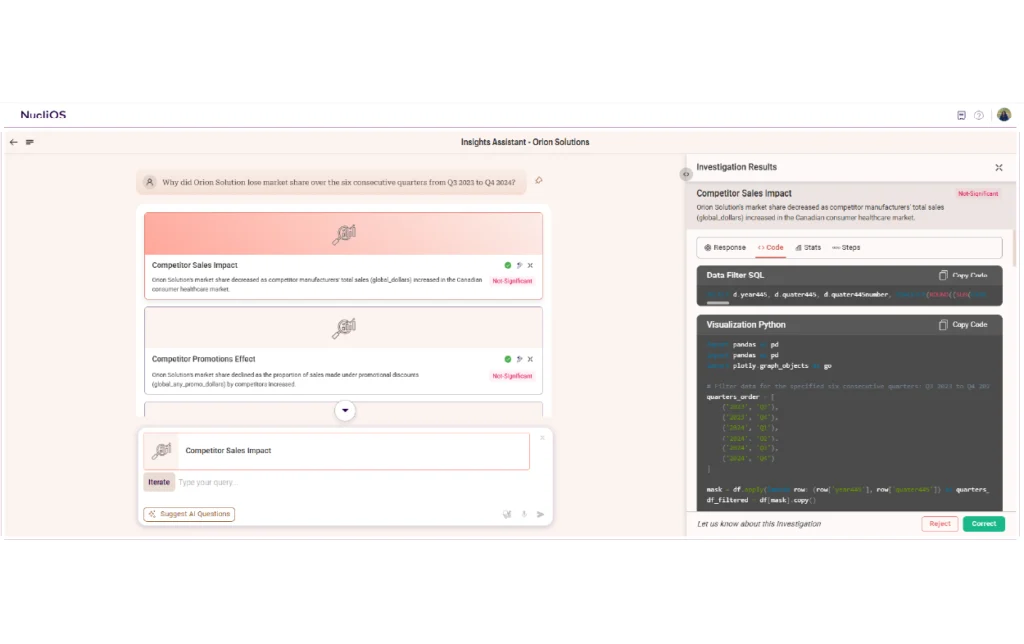
- Once a hypothesis is selected, the EDA Agent generates SQL queries and prepares a data frame.
- The Visualization Agent simultaneously produces Python code (e.g., Plotly) for visual representation.
- This transparency ensures the user can see how the answer was derived.
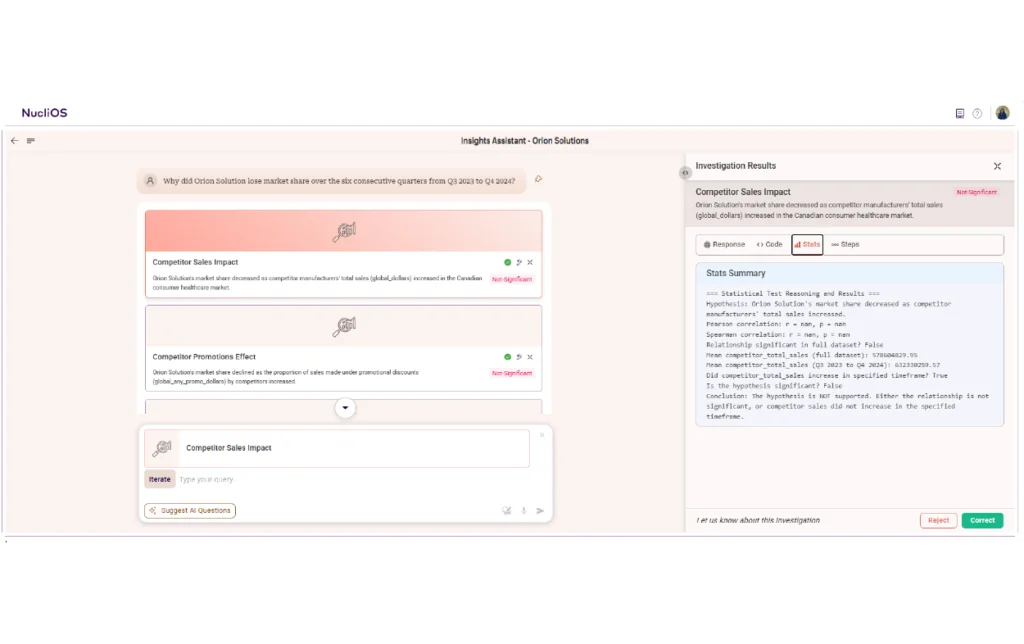
- The Stats Agent tests the selected hypothesis with methods like correlation and significance testing.
- The results here show that competitor sales increases were not statistically significant as a cause for Orion’s decline.
- This demonstrates the assistant’s ability to reject invalid hypotheses.
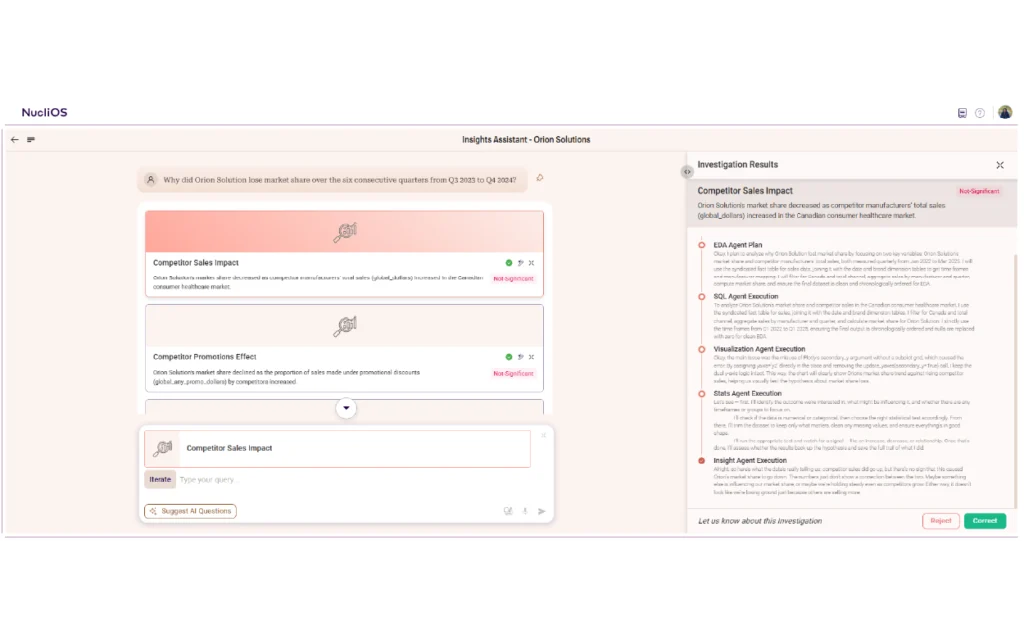
- The workflow view explains step by step how agents worked together:
- EDA Agent plan
- SQL execution
- Visualization
- Stats validation
- Final insights synthesis
- It mirrors a human analyst’s structured approach to investigating “Why”.
- The Visualization Agent’s chart shows Orion’s market share vs competitor sales trend.
- While competitor sales rose, statistical validation confirmed it wasn’t the primary driver—helping narrow down true causes.
The What If Question (Simulation/Forecasting)
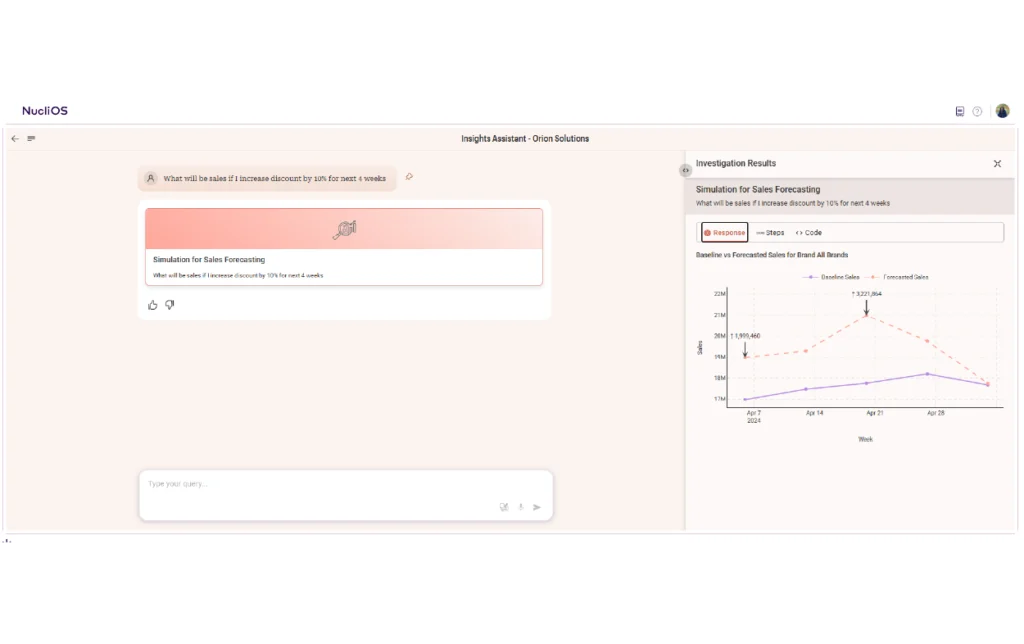
- The user asks: “What will be sales if I increase discount by 10% for the next 4 weeks?”.
- The Planner Agent interprets this as a simulation query and routes it to the Simulation Agent.
- The Visualization Agent outputs a forecast chart comparing baseline vs simulated sales.
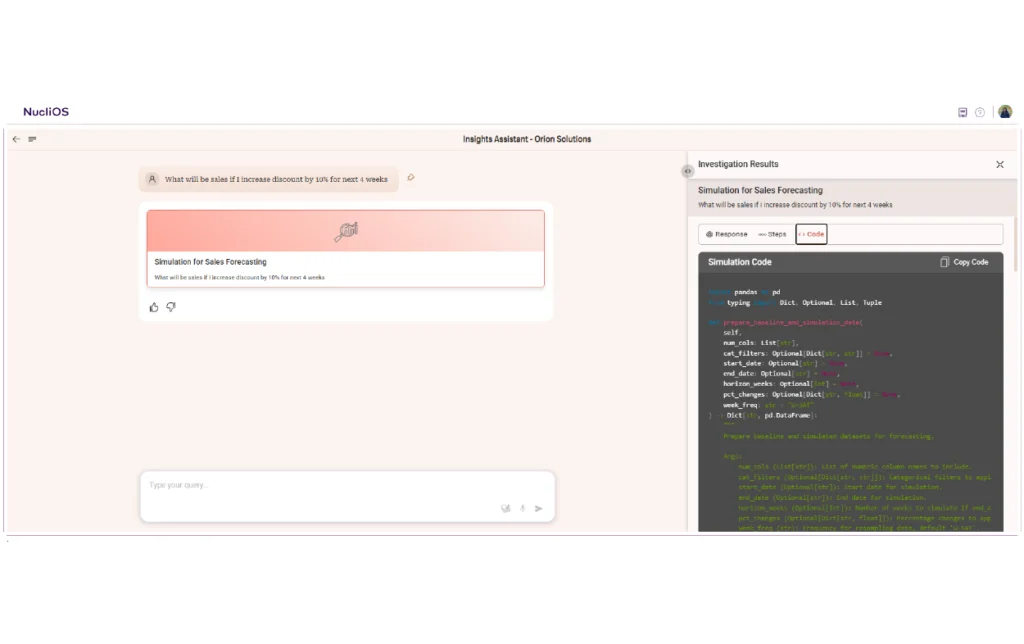
- Behind the scenes, the Simulation Agent generates Python code to create a baseline dataset and simulate the effect of a 10% discount.
- This ensures the forecast is explainable and reproducible.
- It clearly shows the projected sales lift (e.g., +3.2M at peak) over the next four weeks, making the impact of a pricing strategy tangible.
The What’s Next Question (Proactive Drill-Down)

- The steps panel details the process:
- Query analysis
- Simulation data creation
- Model selection & inference
- Visualization
- This allows business users to understand the pipeline without needing technical expertise.
- After completing an analysis, the Drill-Down Agent suggests context-aware follow-ups.
- For example, after seeing attrition results, it may recommend:
- “What factors led to attrition differences by region?”
- “Does employee tenure length impact attrition risk?”.
- This proactive guidance makes investigations continuous rather than one-off, mimicking how human analysts dig deeper.
From What to Why to What’s Next: How the Insights Assistant Delivers
Descriptive (Fact-Finding)
What happened?
The journey begins with descriptive analysis—fact-finding that addresses “what” type questions. When a user submits a query, the Planner Agent interprets intent and designs a workflow to resolve it. The EDA Agent, powered by a text-to-SQL engine with built-in planning, generates the SQL query, fetches the dataset, and organizes it into a structured data frame. This output flows to the Visualization Agent, which creates clear, interactive charts and summaries (e.g., using Plotly) that highlight patterns and trends. Every result is fully transparent—SQL queries, Python transformations, and visual outputs are provided alongside answers, ensuring users can verify the process and reuse logic as needed.
Sample Question: “What is Orion Solutions’ market share and total market sales by category for the financial year 2024?”
Diagnostic Analysis (Root Cause Investigation)
Understanding Why Events Occur
When diagnostic analysis is needed, the assistant goes beyond surface metrics and moves into deep reasoning. Leveraging LLM-powered capabilities, the Hypothesis Agent proposes a set of possible explanations for any “why” question, such as several alternative hypotheses. Each hypothesis is methodically validated: the EDA Agent gathers and prepares the relevant data, the Stats Agent conducts statistical tests like Chi-Square, ANOVA, and correlations, and the Visualization Agent presents the findings in intuitive visuals. The system explicitly indicates which hypotheses are statistically significant, delivering a clear, traceable workflow:
- Generating hypotheses
- Retrieving data (via SQL and Data Frames)
- Running statistical validation
- Visualizing outcomes
- Providing the exact code (SQL and Python) used
This automated, transparent process enables rapid, rigorous root cause analysis—mirroring the approach of human analysts, but at greater speed and scale.
Example Question: “Why did Orion Solution lose market share over six consecutive quarters from Q3 2023 to Q4 2024?”
What-If Analysis (Conditional Reasoning)
Exploring Alternate Scenarios
To answer forward-looking questions like, “What if engagement scores increase by 10%?”, the Planner Agent initiates a tailored analytical pipeline. Conditional logic is applied to manipulate and project changes within the data set. Outcomes are visualized so the user can clearly see, for instance, the potential decline in attrition if engagement scores improve. This empowers analysts not just to explain outcomes, but to simulate and test the impact of future decisions.
Proactive Insights (Follow-Up and Guided Discovery)
Anticipating What Comes Next
While fully open-ended guidance isn’t available yet, the assistant advances proactive analytics through its Drill-Down Agent. Building on EDA results, it generates targeted follow-up questions to help users dig deeper as needed. This means investigations don’t stall—they evolve, guided by AI to surface deeper drivers and context.
Sample follow-up prompts:
- “What is Orion Solutions’ market share and total market sales by category for the financial year 2024?”
- “What will sales be in the next 5 weeks if we increase the discount by 25% for specific brands?”
These context-driven, iterative drill-downs enable users to explore incidents and trends continuously, all within a seamless AI-guided process—no need to restart analyses.
Summary Workflow
- Descriptive: What happened? → Data retrieval + visualization
- Diagnostic: Why did it happen? → Hypotheses + statistical validation + visuals
- What-If: What could happen? → Scenario simulation using predictive models
- Proactive: What should be explored next? → AI-driven, guided follow-up queries
The NucliOS AI Insights Assistant is not just an evolution in analytics—it represents a shift in how organizations think with data. By uniting multi-agent intelligence, dynamic simulations, and end-to-end transparency, NucliOS enables teams to understand the past, reveal causes, anticipate possibilities, and continuously discover next steps. Built for speed, scale, and clarity, it empowers users at all levels to transform every question into decisive, confident action.
